This afternoon, it is my pleasure to be able to introduce to you the distinguished, generous, and somewhat reclusive investigator into Natural History in all its many forms. He is a man of wealth and prominence and yet quite modest. He has traveled extensively and made many important observations and discoveries and yet is not widely known as he eschews the limelight. However, his influence has been extensive and he supports many important projects and has created endowments and research fellowships for promising young people. So, without further adieu, I give you Sherlock Lord ThickThistle.
I say, many thanks Professor for your kind intro and your brave and proper execution of my full name. Rather dicey for most to get it right; try saying it 3 times in quick succession. Anyway, I simply go by Lord Thistle, much less complicated. Drives the Scots bonkers though.
Now, I do indeed want you to think of this as a chat and not some puffed up lecture. Interrupt, ask questions–saves me having to fill up more time. This won’t be anythin’ like the pontificatin’ of Lady Murgatroyd, Dame Malaprop, who couldn’t construct a coherent sentence to save her life. Tiresome old bat who goes on and on about things she fabricates and the poor old git believes they’re true. Encountered her at university when I was still wet behind the ears–dreadful experience.
Well, quite enough of that. I thought that today I might ramble on a bit about some odd critters and their odd names. Plenty of them around, you know. Let’s begin with the nigh invincible tardigrade, extraordinary chappy. First, the name: from the Latin naturally, tardigradus “slow-paced”; “gradi” to proceed and “tardus” slowly–almost enough to make one want to be an etymologist, what? And, no, I don’t means an insect chaser, rather a word chaser. Damn fascinatin’, language, but damn hard to master; so I stick to Natural History, with the occasional bit of Unnatural History thrown in, what? Wordwise, what’s equally interestin’ is the popular names that get attached to critters. In this case, the tardigrade becomes a “water bear” or sometimes a “moss piglet”. Take a peek at what they look like.
They were first described in 1773 by a German zoologist name Goeze who gave them the name of little water bear. To my old brainpan, rather an odd description. It’s true that bears can amble, but they are hardly slow. They do tend to tilt a bit from side to side when ambling, but when they are in full gear they move very rapidly and in a direct line. Try to never be in a situation where you have to outrun one; you’ll likely lose. And those claws–ah, that’s where we do find a bit of resemblance with the tardigrade. As for the moss piglet description; well, tardigrades are indeed found on moss among other places, but again I can’t quite see the little piggy resemblance and besides that piglets are rambunctious when they’re not busy suckling. If it were up to me, I’ve rechristened them as “moss sloths”. Sloths have long claws too and move very slowly like tardigrades. Besides, I like the way it sounds; moss sloths, moss sloths; what, what?
I have taken lately to a great deal of wonderin’ about the names we attach to critters and another instance is the nudibranch. Well, this one is a sort of “gemixte pickles” word; it comes from both Latin and Greek. The Latin part, I suspect we all know, “nudus” or naked and the Greek “brankhia” which means gills. The gills are exposed and displayed often in marvelous assemblages of color. Just take a wee gander at some examples.
I found dozens of specimens when diving out on some of the small coral islands in the South Pacific–lovely place when the sharks aren’t circlin’. Some people call these little beauties “sea slugs” which is an insult and misleadin’, since there’s a bunch of other little slimy crawlies that aren’t related to the nudibranchs at all. Just consider your garden slug that goes muchin’ on your lettuce.
Another misleadin’ bit of terminology is to be found in the realm of those marvelous “air darners” as I call ‘em; the dragonflies and damsel flies. Most amazing aerial acrobatics you ever want to see. However, before they’re airborne, their stage of development is called nymphs. Now, there’s a misnomer if there every was one. Take a look-see at some dragonfly nymphs.
Now, if we check out the etymology, we discover that the Greek word has the meaning of “young woman” and in classical mythology they were described as lovely young maidens who were semidivine. When I look at those images of the dragonfly nymphs that’s not remotely what I can imagine. Take a glance at the kinds of images you get if you Google “water nymphs”–not remotely comparable. What idiot decided to call these insect stages nymphs? Apparently, said idiot had an inklin’ that this was a stupid idea, for I can find no record of anyone admitting to this linguistic blunder, not even old Murgatroyd.
I mentioned sharks a bit ago; fascinating, horrifying critters. They have a right astonishing array of sensors and talents that are stunning, but what I’m interested in at the moment is those nasty teeth. Just take a look at these in the mouth of a Great White.

There’s another fishy with quite small, but razor-sharp teeth that’s quite terrifyin’. That’s, of course the piranha which comes from the language no longer spoken of the Amazonian Tupi tribe. It means “tooth-fish”. Quite a succinct and accurate description, what, what? And what’s more they look awfully like a shark mouth full of teeth, just smaller.

Reminds me of the time when I was 15 and wanted to get a rise out of my pater. He sat all day in his magnificent library, reading and libating with Scotch. I never figured out whether he was indifferent to everything or fascinated by everything. I walked in and told him that I was going to become a cannibal. He peered over the top of his book, look at me earnestly, and said: “Ah, ah, a project. I was just reading about such chappies, in a magazine I think. National Geographic, I’ll try to find it for you if you’d like. Well then, we’ll have to set you up with an appointment with Dr. Philpotts the dentist to get your teeth sharpened.” I could never unravel whether he was always putting me on or whether I succeeded, at least occasionally, in putting him on.
The estate was enormous and he was so wealthy that he could have everything hired to be done for him. Apparently, he trusted that everything necessary would somehow get done. My mother, however, was, if you’ll excuse the expression in this context, quite a different kettle of fish. She was large, formidable, and no-nonsense. She knew to the penny what everything cost and which servant to dismiss for pinching silverware and which servant to retain, because he or she did such a first-class job, even though he or she was also pinching silverware. However, she would let her displeasure be quietly known by assigning extra tasks such as silver polishing and inventorying silverware. The same detailed knowledge was held by her regarding the gardeners, cottage farmers, in fact, everyone who set foot on the estate to do any kind of work. If there was a project, she would tolerate one delay in its completion, but only one.
If I overstepped the bounds, she would let loose with a string of sharp-tongued reprimands and after a bit my father would look up from his book and say: “Pen (short for Penelope), the boy’s just showing a bit of spirit.” Amazin’ I didn’t turn out to be a schizophrenic.
I was a bit afraid of my mother, but she taught me a deep and abiding respect for women of strength and discipline. Probably the reason, I can’t abide certain other types.
Which brings me to another story; didn’t mean to saddle you with so much personal history, but interesting, nonetheless, what, what? As it happened, some years later, I decided to do a bit of explorin’ in the Amazonian basin and took a boat down the Orinoco and as fickle fate would have it, Lady Malaprop was on the same vessel. If it hadn’t been for the fact that all my gear for my expedition was already on board, I would have waited for another boat, but that was not an option. I just resolved to dodge and avoid the creature to the fullest extent possible. She, however, seemed similarly determined to hound me and wandered around taking down near everything I uttered. Worst of all, the old cow had learned that my fist name was Sherlock and she relentlessly shortened it to “Sherl”. Now, as you have doubtless gathered, I am not the silent type but, on this occasion, I was driven to taking a Trappist monastic vow of silence. Fortunately, this worked or I would one evenin’ likely got her all tiddly with whatever wretched witch’s brew she was imbibing and pushed her off as a snack for the piranhas. Hah, you thought I’d forgotten about them–no sirs and madams, these are even more spine chilling in their own wretched way than sharks. Ordinarily, they’re scavengers and only occasionally attack animals that stray into their realm, but if they are injured and weak, the piranhas can strip a good sized animal in minutes. But, on this occasion, no feeding frenzy on British ladies. There have been moments when I wish I had gone ahead and executed my plan; this after reading her miserable, incoherent account of the journey in which she couldn't even get the name of the river right. If you are given to a strange brand of comic punishment, you can find her account here, but I don’t recommend reading when you’re sober.
While we’re in expedition mode, I will report on another toothy encounter, this one in Africa. With a few friends, I went down to the Okavango Delta which is one of the richest wildlife sites in the world. One sultry afternoon, we were sauntering along the waterside and I stuck my walking stick into the water to poke at something of interest. Well, imagine my surprise when that something of interest turned out to be a very large and quite annoyed hippopotamus who came chargin’ up on the bank and only by dividing up and running like hell were we able to confuse him sufficiently to escape. These are not creatures to be toyed with and one might think that because of their size they would be slow on land. Not so, most emphatically not so. They are unquestionably one of the most dangerous animals on the African continent and that’s saying a bit. These things have teeth that are almost mythic in size and character. You can see that here in the photo below. Unfortunately, the size of these teeth has created a black market for them amongst ghoulish collectors. Fortunately, not too many natives are willing to risk confronting hippos and countries have begun to be much more serious about prosecuting poaching and regulating culling. But I digress–do that a lot, people tell me. Here’s a look at a hippo mouth. Wouldn’t want to be his dentist!
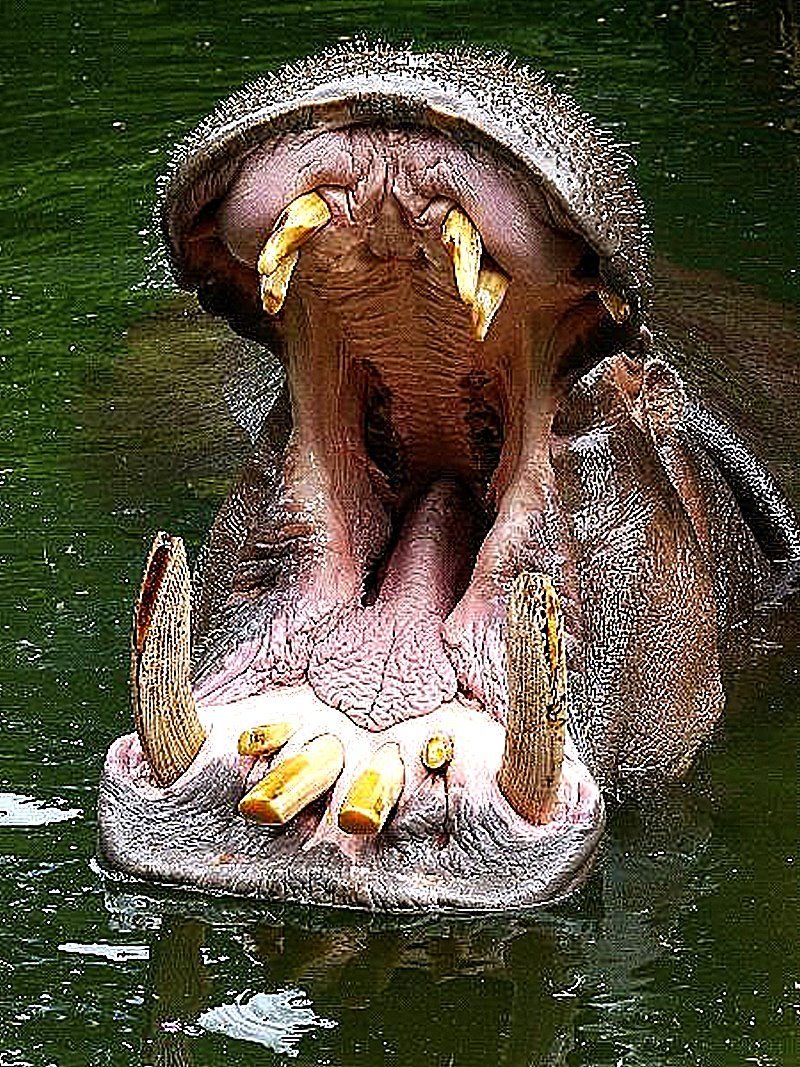
Can’t seem to get away from this business with teeth, perhaps because I have an appointment to get me dentures relined. In spite of what the Aussies say and do, never wrestle with crocodiles!! They can snap their jaws shut at a pressure of over 3,500 pounds per square inch whereas tigers manage only 1,000 psi and when you’re chompin’ on a nice juicy steak, you might manage somewhere between 100 and 150 psi. These crocs are not fellas to be trifled with.
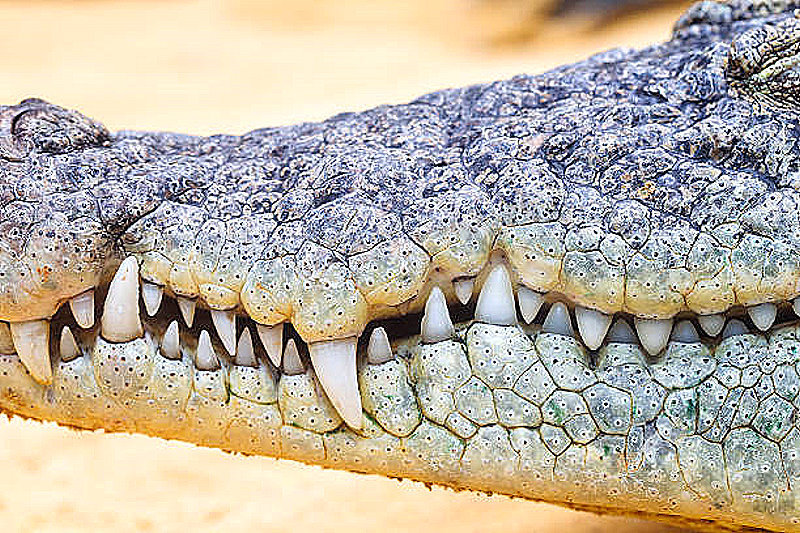
I have found in the course of my investigations into Nature that one must always remember that old saying “Nature, red in tooth and claw.” Many folks believe that that comes either from the Bible or Shakespeare. Well, my investigative instincts led me to be suspicious and so I chased it down to Alfred Lord Tennyson's In Memoriam A. H. H., 1850. If we look at the passage where it occurs, we find an indication that Tennyson was in quite a quandary.
“Who trusted God was love indeed
And love Creation's final law
Tho' Nature, red in tooth and claw
With ravine, shriek'd against his creed”
Here he uses the word “ravine” from the Old French in a sense conveying destruction, robbery, rapine, pillage. The old chap was quite ambivalent in his attitudes toward the developments and rise of science and he found his faith gradually being weakened and began to move more and more to a position which separated religion and Nature. He marveled at the wonders of Nature, but feared the implications of science for his faith.
Now, how’s that for a smooth segue, what, what? We’ve been talkin’ about teeth, so now it seems only natural that we should talk about claws, some of which can be as formidable and as daunting as teeth. Let’s start things off with a giant who will outweigh you, can outrun you, has formidable teeth, and claws that you never want to come within reach of. I’m talking about the Russian bear and here is a closeup snap of a foot full of claws.

This is, of course, not to be confused with the Bear Claw pastry.

While we’re dealin’ with giants, let’s take a gander at quite a different type–an ostrich. The size and speed of these critters can make them quite a danger if they’re riled. Just take a look at the claws on this little birdie.
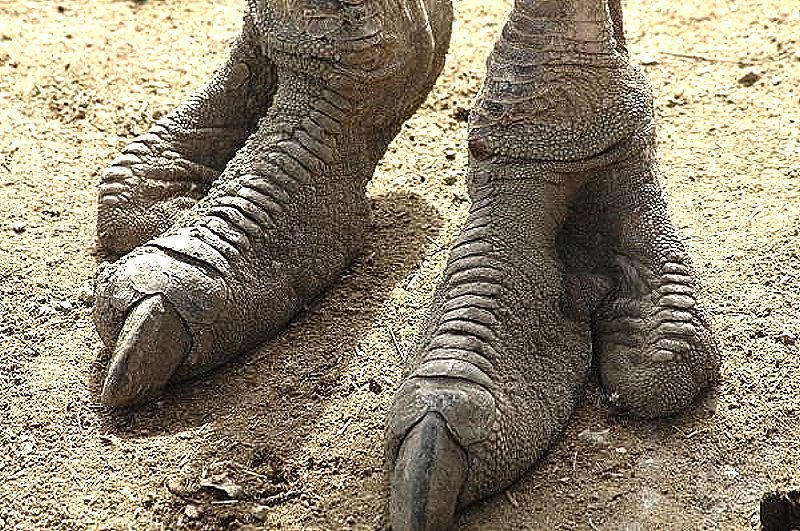
Then, there are the great aerial hunters, the raptors, not to be confused with raptures as old Murgatroyd might well do. These birds are smaller, but have extraordinary eyesight, fiendish accuracy, frightening beaks and claws. I’ll show you here a beak and then the talons of a Peregrine Falcon.
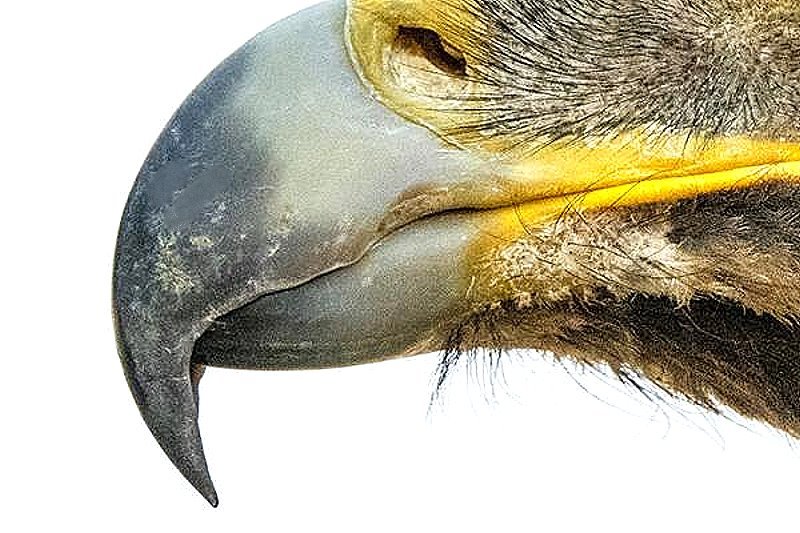
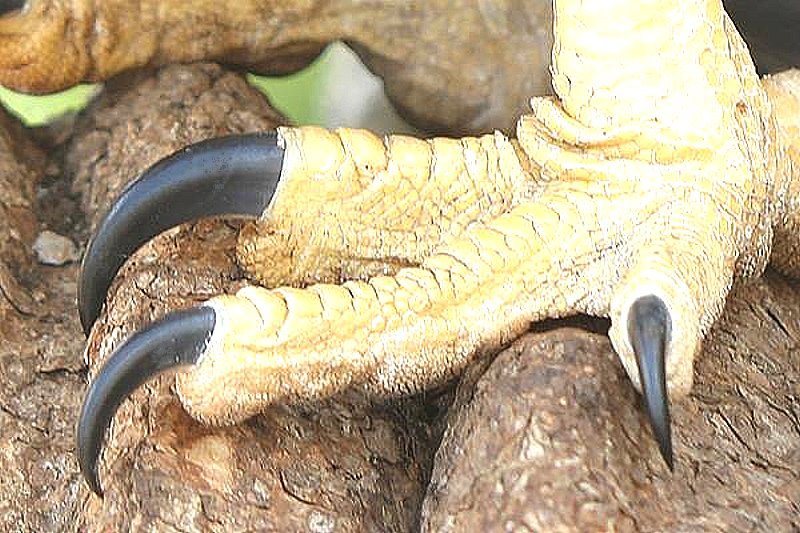
Then there is the Osprey, which I mention only because of one of my investigative encounters with such. I was climbin’ up in the coastal mountains of California and I apparently got a wee bit too close to a nest of one of the fish hawks and this mama came screechin’ and divin’ at me with talons open ready to tear out what ever bits of me flesh she could grasp. I ducked, ran, dodged, ran, ducked until finally she decided I was far enough away to no longer pose a threat. I must tell you, that was a frightenin’ experience, so much so, that I’m afraid I stained myself a bit, emulatin’ Goethe’s Herr Hosenscheisser. It’s quite amazin’ how a lot of these genius types have a taste for the off-colour and created some bits that in their own day were regarded by many as quite unsavory. In fact, Herr Hosenscheisser, (I won’t translate; I’ll let you look it up), is just one of a series of outrageous names in a work which Goethe wrote as a parody of his own great work Faust and circulated only privately among a close circle of friends. Mozart also indulged in scatological send ups as you can experience for yourself by listening to his Canon in B flat for 6 Voices, K. 231 / K. 382c, but BE WARNED, this is downright dirty. If you want a translation of the text, I’ll let you do your own detective work. If it doesn’t make you blush, then you’re damned more worldly than most. Bein’ a detective means you have to follow things out, even if you find yourself discombobulated by the results, what, what? The music is lovely; the text extremely vulgar.
Now, where were we? Ah, yes, I got distracted by the Osprey.
Quite wonderful to watch, but from a safe distance.
To wind up our little investigative ramble, we’ll polish off with some antlers and horns, but no trumpets or trombones here, what, what? Interestingly, horns are made primarily of a fibrous protein called keratin, like what’s in your fingernails and hair. Antlers, on the other hand, are more complex consisting of cartilage, skin, nerves, fibrous tissue, blood vessels and bone. Let’s look at a few examples of each. First the horns of a bison. They look fairly short and harmless and the animals often just graze quietly and people are foolish deceived into believing that it’s safe to approach them to get a “wonderful wildlife PIC”. Well, first off, bison can move very fast and like me, they tend to be grumpy at unnecessary intrusions. Almost every year, a tourist to two or three gets gored, sometime fatally, when he or she disturbs one of these large and moody beasts.
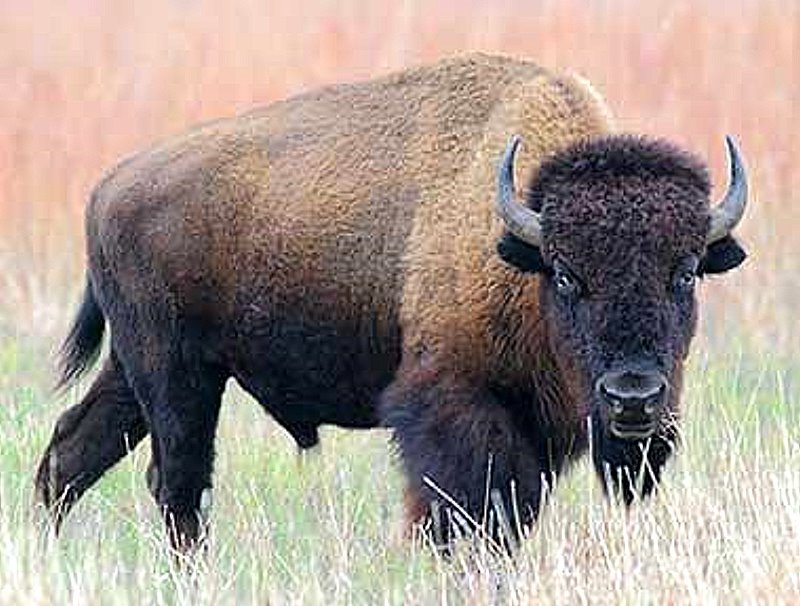
Another critter that gives looks of “DO NOT DISTURB” is the rhinoceros. This fellow however doesn’t have very good eyesight and if a person is motionless it can’t see him or her. However, don’t let that lull you into complacence; they have a very keen sense of smell and if one of these comes lumbering after you, you had better have picked out a refuge.

Now, if you’re feeling really horny, (oh, get your mind out of the gutter), you could go to Texas and see out a Texas longhorn steer. These have been domesticated and you’re more likely to get trampled than gored with these beasts.
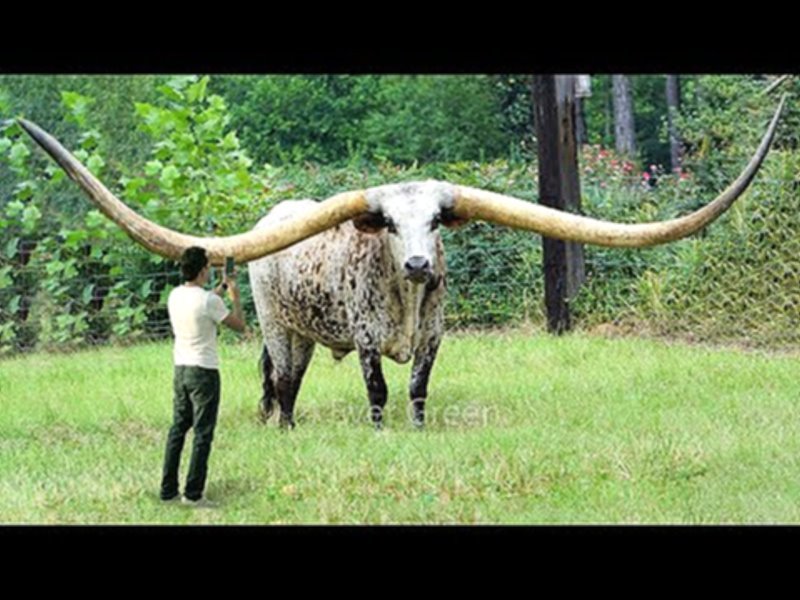
So, let’s move on to antlers. Two examples common in the U.S. are Elk and Moose. Both have impressive racks of antlers and these are often collected by hobbyists and dealers after they go through the shedding process. The living creatures are large, impressive, and dangerous when disturbed. First an elk and then a moose.

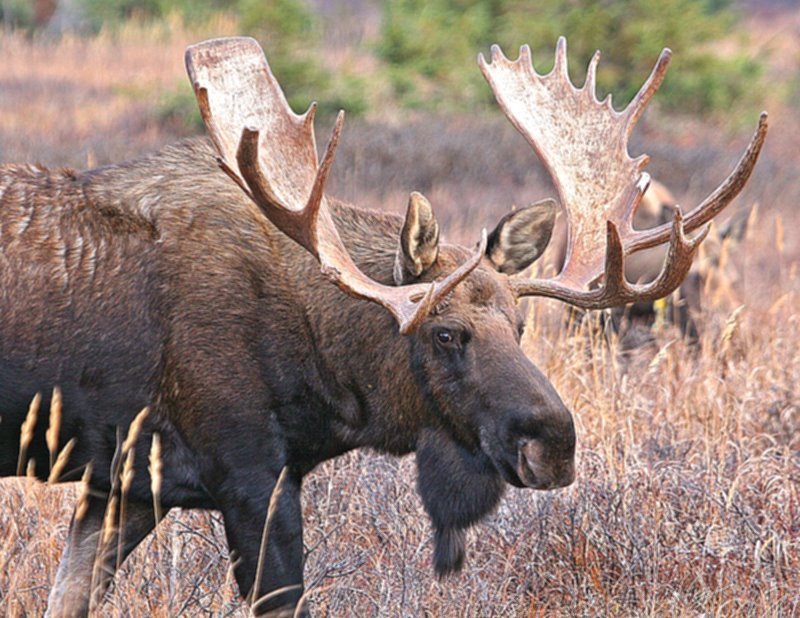
Finally, let’s trot off to Africa again and take a look at Oryx. These are a stunning type of antelope with splendid horns. They are not ordinarily aggressive, but only the foolish like Lady Malaprop would dare to approach them and I’m bloody well sure that she couldn’t outrun one, but it’s nice to imagine the scene of plumpy Murgatroyd being pursued by an Oryx. But, I don’t want to spoil things; just take a look at this magnificent creature.
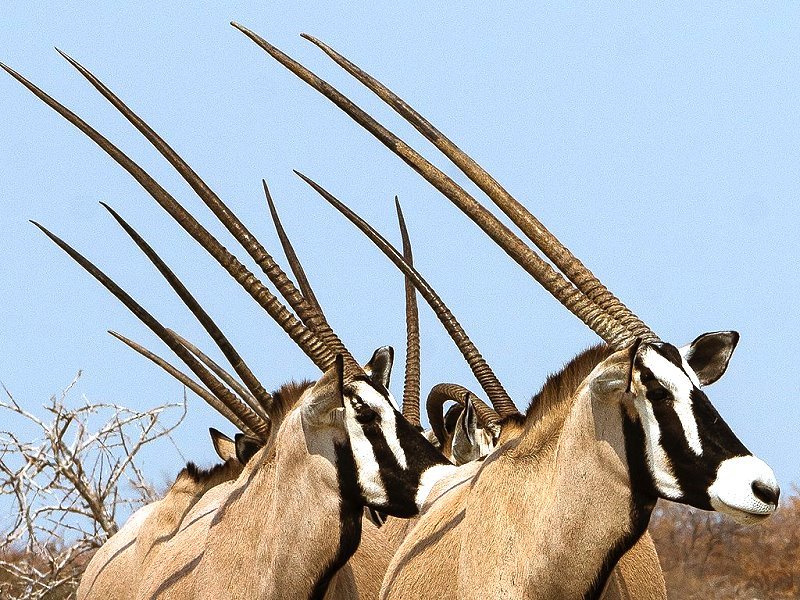
Well, I do fervently hope that you’ve enjoyed our chat and it’s too bad that none of you had the moxie to interrupt me and ask some questions so that I didn’t keep blatherin’ on and on. Oh, well, I had some fun and I hope you did too. So, until next time, Cheers.
NOTE: The images are to be found on Google and the music video of Mozart on YouTube.